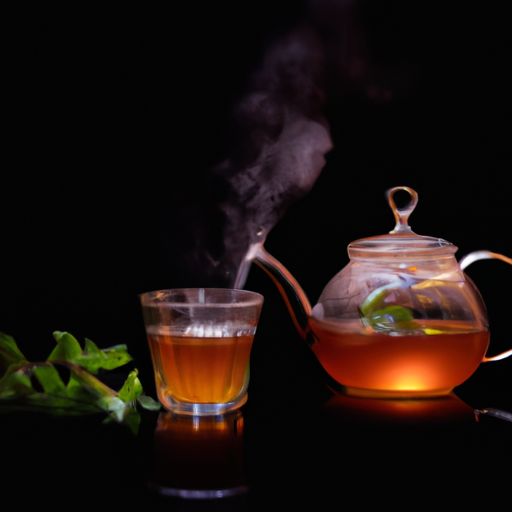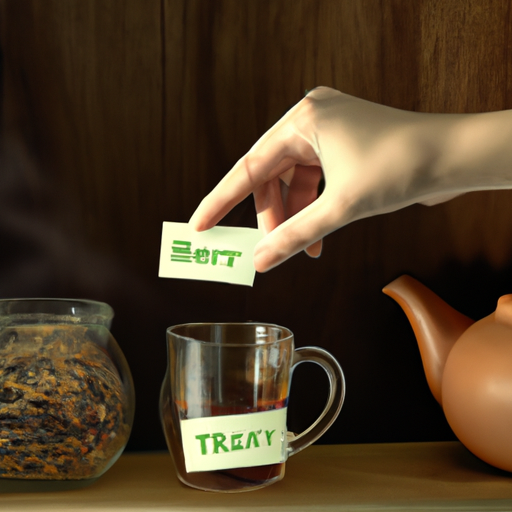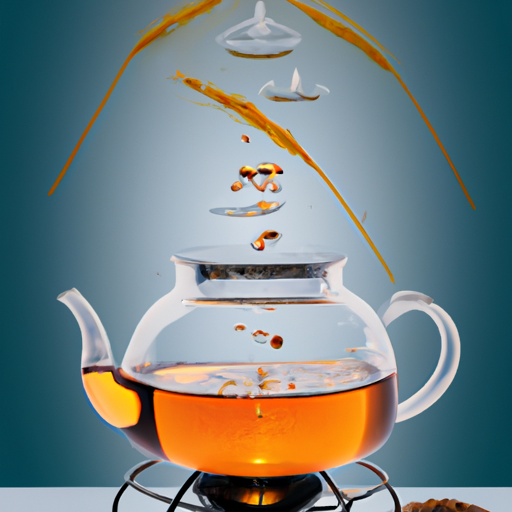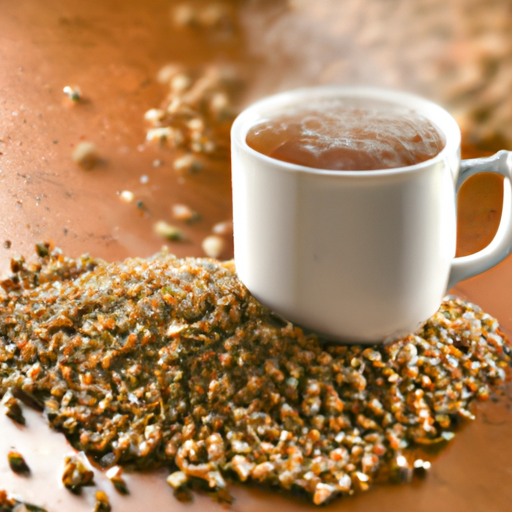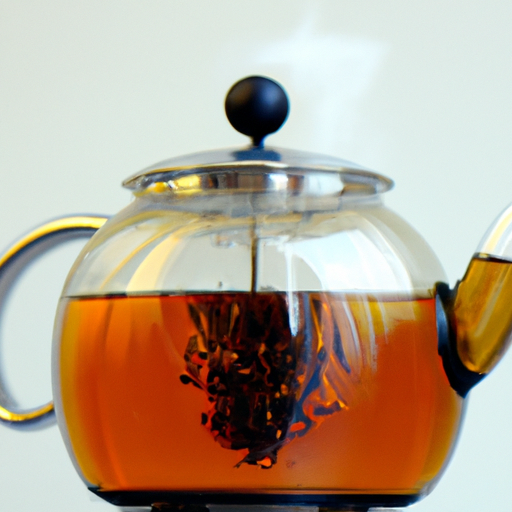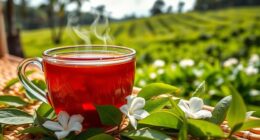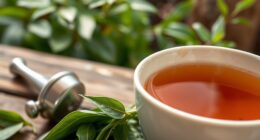As an enthusiast who enjoys exploring different types of tea, finding the deep, nutty taste of barley tea was a delightful surprise. Its delicious flavor, coupled with its numerous health advantages, makes it an excellent supplement to any tea assortment.
In this article, I will share with you my step-by-step process for brewing the perfect cup of barley tea, from selecting the right grains to serving it hot or cold.
First, it’s important to understand what barley tea is and why it’s worth trying. Barley tea, also known as roasted barley tea or mugicha, is a caffeine-free tea made from roasted barley grains. It originated in East Asia and has since become a popular drink around the world, particularly in the summer months when it’s served iced.
Besides its unique flavor profile, barley tea is also known to aid digestion, improve circulation, and even help with weight loss. So, let’s get started on brewing our own batch of barley tea!
Key Takeaways
- Choose hulled barley grains and roast them in the oven or on the stovetop to bring out their nutty flavor.
- Simmer the tea for longer to achieve a stronger, more robust flavor, or for less time for a milder taste.
- Strain the tea to remove any leftover barley grains or debris.
- Store the tea in the refrigerator for optimal freshness and consume within two to three days.
Understanding Barley Tea and Its Health Benefits
If you’re looking for a refreshing and healthy beverage, you can’t go wrong with barley tea. Not only does it taste great, but it’s also packed with antioxidants and has been shown to improve digestion and lower cholesterol levels.
In fact, studies have found that drinking barley tea regularly can help prevent heart disease and other chronic conditions.
To make barley tea, you’ll need to start with the right barley grains. Look for hulled barley, which is an unprocessed grain that still has its outer shell intact. You can find hulled barley at most health food stores or online.
Once you have your barley grains, you’ll need to roast them in the oven or on the stovetop to bring out their nutty flavor. There are many different barley tea recipes and brewing techniques to choose from, so be sure to experiment and find the method that works best for you.
Choosing the right barley grains is just the first step in brewing a delicious and healthy cup of barley tea. In the next section, we’ll explore the different types of barley and how to prepare them for brewing.
So whether you’re a seasoned tea drinker or a newcomer to the world of barley tea, stay tuned for more tips and tricks on how to make the perfect cup!
Choosing the Right Barley Grains
Like selecting the perfect coffee bean, finding the right grains is crucial for a delicious cup of roasted grain infusion. When it comes to choosing the right barley grains for brewing barley tea, there are a few factors to consider.
Firstly, the type of barley grain you choose will affect the flavor profile of your tea. For example, hulled barley grains will give your tea a nuttier flavor, while pearled barley grains will produce a sweeter taste. It’s important to choose a barley grain that will suit your personal taste preferences.
Once you’ve decided on the type of barley grain you want to use, it’s time to consider toasting techniques. Toasting the barley grains before brewing can enhance the flavor of your tea. There are a few methods for toasting barley, including toasting in a dry skillet or roasting in the oven. Toasting times and temperatures may vary depending on the desired intensity of the flavor. Keep in mind that over-toasting can result in a burnt taste, so it’s important to monitor the grains closely.
Choosing the right barley grains and toasting technique can make all the difference in the flavor of your brewed barley tea. Once you’ve toasted your grains to perfection, it’s time to prepare them for brewing.
In the next section, we’ll discuss the steps for preparing the roasted barley grains to make a delicious cup of barley tea.
Preparing the Roasted Barley Grains
Get ready to make a delicious cup of roasted grain infusion by preparing the perfectly toasted barley grains using these easy steps. First, preheat your oven to 350°F and spread the barley grains evenly on a baking sheet.
You can also use alternative grains like corn, brown rice, or wheat to add more flavors to your tea.
Next, place the baking sheet in the oven and roast the grains for about 15 minutes, making sure to stir them every five minutes. Roasting techniques can vary depending on your preference, but for a strong and nutty flavor, roast the grains until they turn dark brown. Be careful not to burn the grains, as it may affect the taste and aroma of your tea.
Once the grains are toasted to perfection, remove them from the oven and let them cool for a few minutes. This will allow the grains to settle and release their natural oils and flavors.
Now that the roasted barley grains are ready, it’s time to move on to the next step of boiling the barley tea.
Boiling the Barley Tea
Now it’s time to start boiling your roasted grain infusion, so bring a pot of water to a rolling boil and add in the perfectly toasted grains.
Once the barley is added, reduce the heat to a gentle simmer and let it cook for about 10-15 minutes. During this simmering process, the barley grains will release their flavors and aromas into the water, creating a delicious and fragrant tea.
As the barley tea simmers, it’s important to stir occasionally to ensure that all of the flavors are melding together in perfect harmony. This will also help prevent the grains from sticking to the bottom of the pot and burning.
Depending on your preferences, you can adjust the simmering time to achieve different flavor variations. Longer simmering times will result in a stronger, more robust flavor, while shorter simmering times will produce a milder taste.
After simmering for the desired amount of time, turn off the heat and let the tea cool for a few minutes. Once it has cooled, you can strain the tea using a fine mesh strainer or cheesecloth, and store it in an airtight container in the refrigerator.
This will keep your barley tea fresh for up to a week, so you can enjoy it anytime you want!
Straining and Storing Barley Tea
Now that I’ve boiled my barley tea, it’s time to strain and store it.
I like to use a fine mesh strainer to remove any leftover barley grains or debris from the tea.
After straining, I transfer the tea to a glass pitcher and let it cool before storing it in the refrigerator for later use.
Using a Strainer
Using a strainer is like filtering the golden-hued tea through a sieve, catching any stray barley grains and leaving behind a smooth, refreshing brew. There are different types of strainers to choose from, such as a fine mesh strainer or a cheesecloth. The type of strainer you use can affect the flavor of your barley tea. For example, using a cheesecloth can result in a lighter and more delicate brew, while a fine mesh strainer can give you a stronger and more robust flavor.
When straining your barley tea, it’s important to consider the desired flavor. If you want a lighter brew, use a cheesecloth to strain the tea. If you prefer a stronger flavor, use a fine mesh strainer. Additionally, you can strain the tea multiple times to achieve a smoother and more refined taste. Once you’ve strained the tea to your liking, it’s time to store it properly to maintain its freshness and flavor.
Storing Barley Tea
To keep your refreshing barley tea fresh and flavorful, it’s best to store it properly. Proper storage is essential to maintain its quality and extend its shelf life. Here are three tips for storing barley tea:
-
Store in an airtight container: Make sure to transfer your barley tea to an airtight container before storing it in the refrigerator. This will prevent any outside odor or moisture from seeping into the tea, which can affect its flavor and quality.
-
Keep it cool: Barley tea is best stored in the refrigerator. The cool temperature helps preserve its freshness and flavor. Avoid leaving it at room temperature for too long, as this can cause the tea to spoil quickly.
-
Consume within a few days: Although barley tea can last for a few days in the refrigerator, it’s best to consume it within two to three days for optimal freshness.
Now that you know how to store your barley tea properly, let’s move on to the next step of serving it hot.
Serving Barley Tea Hot
When you want to warm up with a comforting cup of barley tea, simply steep the tea bags in hot water and enjoy the rich, nutty flavor that will soothe your soul. Drinking hot tea has many benefits, such as aiding digestion and boosting your immune system. To fully enjoy your cup of hot barley tea, it is important to choose the right type of tea cup for serving.
There are different types of tea cups to choose from, each with their own unique features. For example, a porcelain cup with a lid can help keep your tea hot for a longer period of time, while a glass cup allows you to see the beautiful color of the tea. No matter which type of cup you choose, make sure to preheat it by pouring hot water into the cup before adding your tea.
To further enhance your tea experience, consider incorporating a tea ceremony into your routine. This can involve simple gestures such as holding the cup with both hands or taking a moment to appreciate the aroma before taking a sip. By taking the time to fully appreciate your hot barley tea, you will not only enjoy the delicious taste, but also the many benefits it has to offer. And if you prefer your barley tea cold, don’t worry – there are plenty of ways to enjoy it that way too.
Serving Barley Tea Cold
Chilling your cup of barley tea is a refreshing way to enjoy its unique flavor and health benefits, making it a perfect summer beverage. To make a delicious cold barley tea, start by brewing it hot and then let it cool down to room temperature. Once it’s cooled, you can pour it over ice and add a few sweeteners to taste.
Here are some additional tips to elevate your cold barley tea experience:
- Add a squeeze of lemon or lime to give your tea a tangy twist. This will add a refreshing citrus flavor to your tea and help to balance out any sweetness from the added sweeteners.
- Garnish with mint or basil leaves for a pop of color and flavor. Herbs are a great way to add a fresh and fragrant element to your drink, and they also make your cup of barley tea look extra pretty.
Overall, serving barley tea cold is a great way to cool down and enjoy all the benefits of this healthy beverage. Not only is it delicious and refreshing, but it’s also low in calories and rich in antioxidants. So next time you’re looking for a tasty and healthy summer drink, give cold barley tea a try!
In the next section, we’ll explore some of the amazing health benefits of barley tea.
Health Benefits of Barley Tea
Serving barley tea cold is a refreshing way to enjoy this beverage during hot summer days. However, aside from its cooling effect, it also offers numerous health benefits. In fact, barley tea has been a popular drink in East Asian countries for centuries, not only for its taste but also for its medicinal properties.
Barley tea is said to aid in digestion, promote detoxification, and reduce inflammation. It is also known to have anti-cancer and anti-diabetic properties, making it a great drink for those who are health-conscious. Moreover, barley tea is low in calories, making it an excellent alternative to sugary drinks.
Aside from enjoying barley tea as a refreshing drink, there are also many ways to incorporate it into various recipes. For instance, you can use it as a base for soups, stews, and sauces. You can also add it to your smoothies or use it to make ice cream. With its nutty and earthy flavor, barley tea can add a unique taste to any dish.
Moving forward, let’s talk about the different variations of barley tea and how you can make them at home.
Variations of Barley Tea
There are various ways to prepare and enjoy different types of barley-infused drinks at home. Barley tea, or mugicha, is a popular beverage in Japan and Korea, but it can also be enjoyed in other parts of the world. Here are some variations of barley tea that you can try:
-
Roasted barley tea: This is the most common type of barley tea. It’s made by roasting barley grains until they turn brown, and then steeping them in hot water. Roasted barley tea has a nutty, toasty flavor that pairs well with savory dishes.
-
Barley and green tea blend: For a lighter and more refreshing flavor, you can mix barley tea with green tea. This blend is popular in Korea, where it’s called nokcha mugicha. It has a delicate, grassy flavor that’s perfect for hot summer days.
-
Barley and ginger tea: Adding fresh ginger to barley tea can give it a spicy kick. This blend is popular in China, where it’s called maicha. It has a warming flavor that’s great for cold weather.
-
Barley and fruit tea: You can also mix barley tea with fruit juice or fresh fruit to create a sweet and fruity drink. This blend is popular in Taiwan, where it’s called shihchuan cha. It’s a refreshing drink that’s perfect for hot summer days.
-
Barley and milk tea: For a creamy and comforting drink, you can mix barley tea with milk. This blend is popular in Hong Kong, where it’s called yin yang cha. It has a rich and satisfying flavor that’s perfect for cold weather.
Barley tea has cultural significance in many parts of Asia. In Japan, it’s a popular drink during the summer months, as it’s believed to help cool down the body. In Korea, it’s a traditional drink that’s served to guests as a sign of hospitality. In China, it’s believed to have health benefits, such as improving digestion and boosting the immune system. In Taiwan, it’s a popular drink that’s enjoyed with meals or as a refreshing snack.
When pairing barley tea with food, consider the flavor profile of the dish. Barley tea has a mild, nutty flavor that pairs well with savory dishes, such as grilled meats, stews, and stir-fries. It also pairs well with spicy dishes, as it can help to cool down the palate. For a sweet and fruity drink, pair barley and fruit tea with light desserts, such as fruit salad or sorbet. And for a rich and creamy drink, pair barley and milk tea with pastries or baked goods.
Frequently Asked Questions
Can barley tea be consumed by people with gluten intolerance?
When it comes to consuming barley tea with gluten intolerance, it’s important to note that barley contains gluten, making it unsuitable for those with the condition.
However, there are gluten-free substitutes such as brown rice tea or buckwheat tea that are just as delicious and offer similar health benefits for non gluten intolerant individuals.
Barley tea is known for its high antioxidant content, which can aid in digestion and improve cardiovascular health. It also has a natural diuretic effect, making it a great choice for those looking to reduce bloating and water retention.
So, while those with gluten intolerance may need to steer clear of barley tea, there are plenty of other options available to enjoy the same health benefits.
Does adding sweeteners affect the health benefits of barley tea?
Adding sweeteners to barley tea can definitely affect its health benefits. While barley tea is naturally low in calories, adding sweeteners like sugar or honey will increase the calorie count. This can be problematic for individuals who are trying to manage their weight or blood sugar levels.
Furthermore, sweeteners can also mask the natural flavor of barley tea and make it less enjoyable to drink. In terms of nutritional value, sweeteners provide empty calories and no additional nutrients. Therefore, it’s best to avoid adding sweeteners to barley tea to fully reap its potential health benefits.
How long does barley tea stay fresh if stored in the refrigerator?
As a barley tea enthusiast, I know that storing barley tea can be tricky. The shelf life of barley tea, if stored properly in the refrigerator, is about a week. However, the taste of the tea may degrade after a few days.
It’s important to use a clean container to store the tea and to keep it away from strong-smelling foods. As for the type of barley grain to use, I prefer the gluten-free variety for its health benefits. Adding sweeteners, such as honey or sugar, may affect the health benefits of the tea, but it ultimately comes down to personal preference.
Using a coffee maker to brew barley tea is a convenient option, and the taste profile differs depending on the type of barley grain used. Overall, knowing how to store barley tea properly will ensure maximum freshness and taste.
Can barley tea be brewed using a coffee maker or a French press?
When it comes to brewing barley tea, there are a few different methods you can use. It’s traditionally brewed in a pot on the stove, but it’s also possible to use a coffee maker or a French press. Each method will yield a slightly different flavor profile, so it’s worth experimenting to see which one you prefer.
When using a coffee maker, simply add the barley tea leaves to the filter basket and brew as you would with coffee. With a French press, add the barley tea leaves to the press, pour hot water over them, and let steep for a few minutes before pressing down the plunger.
Regardless of which method you choose, be sure to follow the instructions for brewing barley tea carefully to ensure the best possible flavor.
How does the taste of barley tea vary depending on the type of barley grain used?
As someone who’s tried various types of barley grains for brewing tea, I can say with confidence that the flavor profile of barley tea does vary depending on the type of barley used.
Hulled barley tends to have a nuttier and slightly sweeter taste, while pearl barley has a milder and more neutral flavor. Additionally, the brewing techniques for different barley grains can also affect the taste.
For hulled barley, longer steeping times and higher temperatures can bring out more of its complex flavors, while pearl barley may benefit from shorter steeping times to prevent bitterness. Overall, experimenting with different types of barley and brewing methods can lead to a more nuanced and enjoyable barley tea experience.
Conclusion
In conclusion, brewing barley tea is a simple and enjoyable process that can’t only quench your thirst but also offer numerous health benefits.
As I’ve learned, selecting the right barley grains and preparing them properly can make a significant difference in the taste and aroma of the tea. Boiling the grains for the right amount of time and straining them correctly can also enhance the overall experience.
In my experience, I’ve found that serving barley tea hot with a touch of honey is a comforting and soothing way to enjoy this beverage. Alternatively, adding some ice and a slice of lemon can create a refreshing and invigorating cold barley tea.
As the saying goes, "Variety is the spice of life,"and there are many ways to experiment with different ingredients and brewing techniques to create your own unique version of barley tea.
Overall, brewing barley tea is an excellent way to incorporate a healthy beverage into your daily routine. Whether you prefer it hot or cold, sweet or savory, there are countless ways to enjoy this versatile drink.
So, go ahead and brew yourself a cup of barley tea and savor the warmth and richness of this ancient beverage!


